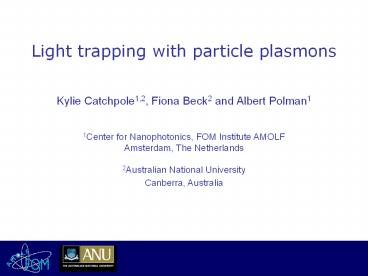Light trapping with particle plasmons - PowerPoint PPT Presentation
1 / 21
Title:
Light trapping with particle plasmons
Description:
Albedo. Metal nanoparticle scattering. Cross section 1. All light captured and scattered ... 3) D 100 nm albedo 0.95 i.e. Ohmic losses 5% 4) Angular ... – PowerPoint PPT presentation
Number of Views:131
Avg rating:3.0/5.0
Title: Light trapping with particle plasmons
1
Light trapping with particle plasmons
Kylie Catchpole1,2, Fiona Beck2 and Albert
Polman1 1Center for Nanophotonics, FOM
Institute AMOLF Amsterdam, The Netherlands 2Austr
alian National University Canberra, Australia
2
Poor absorption below the bandgap
Indirect bandgap Semiconductor (Si) poor
absorption just below the bandgap ? thick cell
required
Eg
solar spectrum
Si solar cell
3
Solution light trapping
- Goal
- Increased efficiency (IR response)
- and/or
- Reduced thickness (cost)
4
Plasmon-enhanced photocurrent 5 examples
Stuart and Hall, APL 69, 2327 (1996)
Derkacs et al., APL 89, 93103 (2006)
SOI
a-Si
Nakayama et al., APL 93, 121904 (2008)
Pillai et al., JAP 101, 93105 (2007)
GaAs
5
Plasmon-enhanced photocurrent 5 examples
Stuart and Hall, APL 69, 2327 (1996)
Derkacs et al., APL 89, 93103 (2006)
SOI
a-Si
What are the physical principles and limitations
Nakayama et al., APL 93, 121904 (2008)
Pillai et al., JAP 101, 93105 (2007)
GaAs
6
Light scattering
Rayleigh scattering from point dipole
Scattering from point dipole above a substrate
p
4
Preferential scattering into high-index substrate
96
See, e.g. J. Mertz, JOSA-B 17, 1906 (2000)
7
Metal nanoparticle scattering
Scattering vs Ohmic lossesAlbedo ? 1 for D gt
100 nm
Resonant scattering
Ag
Albedo
Absorption r3 Scattering r6
Plasmon resonance ? -2?m(?)
8
Metal nanoparticle scattering
All light captured and scattered into substrate
(AR coating)
Cross section gt 1
9
Resonance tunable by dielectric environment
Ag, D100 nm
Si (n3.5)
Si3N4 (n2.00)
Q
Q
O
D
D
H
Optics Express (2008), in press
10
From point dipole to particle plasmon
96
FDTD calculations
Fraction scattered into substrate highest for
cylinder hemisphereStrongest near-field
coupling Tradeoff larger size ? larger albedo
but lower coupling
Appl. Phys. Lett. 93, 191113 (2008)
11
Maximum path length enhancement
Geometric series
Highest path length enhancement for cylinder and
hemisphere
Appl. Phys. Lett. 93, 191113 (2008)
12
Scattering cross-section with dielectric spacer
sscat normalized to particle area
Larger spacing Interference in driving
field But lower coupling fraction ( local
density of states variation modifies albedo)
Q
30 nm
tot
D
sub
10 nm
Appl. Phys. Lett. 93, 191113 (2008)
13
Ag nanoparticle formation on SiO2/Si3N4/TiO2 on Si
Thermal evaporation of 14 nm Ag
300 C anneal
Thermal SiO2 dave 135 nmf 26n1.46
LPCVD Si3N4 dave 220 nm f 28n2.00
APCVD TiO2 dave 215 nm f 30n2.50
14
Optical absorption (1-R-T) in Si wafers
Integrating sphere
SiO2Si3N4 TiO2
30 nm
100 µm
c-Si
c-Si
SiO2
Si3N4
Ref.
Ref.
TiO2
TiO2
Strongly enhanced near-IR absorption egineered by
dielectric spacer
Si3N4
AR effect, interference for shorter wavelength
redshift
SiO2
15
Photocurrent, external quantum efficiency
Si3N4
TiO2
front
SiO2
front
front
back
back
back
Red-shifted EQE enhancement with refractive index
of underlying dielectric Decrease at short
wavelength due to phase shift Small
increase at long wavelength for TiO2
16
Relative photocurrent, EQE enhancement
TiO2 coated Si EQE enhancement 2.7 fold at ?
1050 nm
Note particle size and distribution are not
optimized
17
Design principles for plasmon-enhanced solar cells
1) Metal nanoparticles ?scat gt 1 2) Coverage
10-20 required 3) Dgt100 nm ? albedo gt 0.95
i.e. Ohmic losses lt 5 4) Angular
distribution (path length) increased 5)
Coupling fraction f 0.96 for point
dipole 6) f reduces for larger particle size 7)
?scat increases with spacer thickness 8) f
decreases with spacer thickness Design parameter
optimization Include inter-particle coupling
18
Appl. Phys. Lett. 93, 191113 (2008)
19
Substrate Conformal Imprint Lithography
Full-wafer soft nano-imprint
- Flexible rubber on thin glass
- Conform to substrate bow and roughness
- No stamp damage due to particles
Marc Verschuuren, Hans van SprangSpring MRS
2007, 1002-N03-05
20
Angular dependence of scattered light
Lambertian dav2
Dipole dav1.5
Increased power around critical angle for dipole
compared to isotropic Lambertian less
oblique path
K.R Catchpole and A. Polman, APL (2008)
21
Tadeoff between cross section and incoupling
Point dipole
Optics Express (2008), in press































